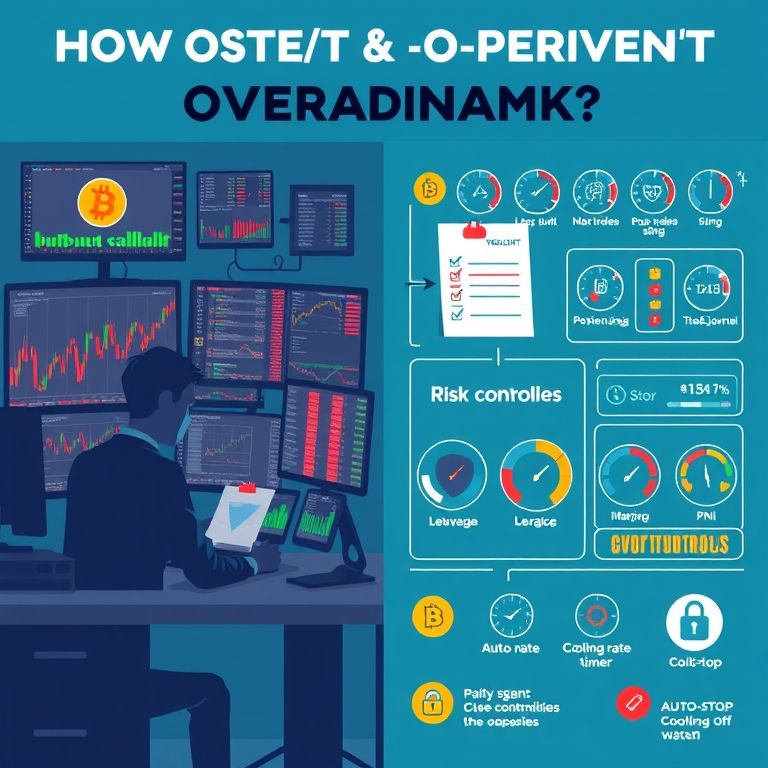How to spot and prevent overtrading in perpetual markets?
How to Spot and Prevent Overtrading in Perpetual Markets?
Introduction
Perpetual futures keep traders glued to the screen—funding rates flip, liquidity shifts, and every tick feels like a signal. When the adrenaline starts running hotter than the alarm clock, overtrading can sneak in: more trades, not enough edge, bigger risk. This piece breaks down practical ways to spot the urge early, set guardrails, and trade smarter across assets—from forex and stocks to crypto, indices, options, and commodities. The goal: channel momentum into planful decisions, not a rapid-fire death by a thousand trades.

Spotting the signs of overtrading
- Traffic overload in the brain: a flurry of quick entries after every minor move, chasing small profits while ignoring risk. If you’re “always in,” look for fatigue, sloppy sizing, or broken trade plans.
- Eroding edge indicators: shrinking win rate, rising drawdown, and profits that vanish when fees and funding costs are tallied. If your P&L looks better in charts than in real life after costs, that’s a red flag.
- Leverage escalation: increasing leverage to chase returns after a string of losses, or reopening the same trade repeatedly in volatile markets. High leverage magnifies mistakes fast.
- No trade diary: skipping post-trade reviews or not documenting rationale makes the pattern recur. If you can’t explain why you took a trade, you probably shouldn’t have taken it.
Practical risk controls and prevention techniques
- Set hard guardrails: daily loss caps, a maximum number of trades per session, and a cap on total capital risk per day (think 1–2% of account value). If you hit the limit, step away.
- Trading plan with “cool-downs”: outline entry criteria, preferred setups, and required breaks after a set number of trades or a drawdown milestone. Breaks lower the chance of impulse entries.
- Size with intention: use fixed fractional risk or a strict percent of capital per trade. Avoid scaling up in one go after a win or a loss.
- Automate where sensible: consider trailing stops, OCO orders, and alerts that enforce your plan. Let your system cut losses and protect profits when you’re not watching.
- Journaling and review: record rationale, outcomes, and lessons. Weekly reviews catch recurring biases like FOMO or revenge trading.
Leverage and asset diversification considerations
- Across assets, the discipline stays the same: different markets demand different volatility budgets. In forex, news-driven moves can spike risk; in crypto, ophidian liquidity and funding rates demand quick checks. Diversification can reduce single-market drawdowns but never substitutes for a risk cap.
- For perpetuals, calibrate leverage to volatility and time horizon. Lower leverage in high-volatility sessions; reserve higher leverage for calm, well-validated setups, not revenge trades after a loss.
Tech tools, charts, and safety nets
- Chart analysis tools and on-chain data can illuminate risk, but they need guardrails. Use multi-timeframe confirmations, volume spikes, and funding-rate checks to distinguish noise from edge.
- Risk dashboards that quantify exposure, correlation, and remaining daily risk help keep you honest. Pair them with alert systems so you don’t rely on memory alone.
- Security and reliability matter: verify exchange or protocol security, monitor liquidity depth, and stay mindful of slippage in fast-moving markets.
DeFi landscape: promises, challenges, and realism
- Decentralized finance offers permissionless access, but it brings new risks: smart contract bugs, MEV (miner extractable value), front-running, and fragmented liquidity. Oracle reliability and cross-chain issues can distort price feeds and funding dynamics.
- Advanced traders blend on-chain signals with off-chain risk discipline. The frontier is exciting, yet you must respect custody, gas costs, and protocol governance as part of your risk model.
Future trends: smart contracts, AI-driven trading
- Smart contracts enable programmable risk controls: automated position sizing, dynamic stop rules, andPortfolio-level margin checks that keep you within a safe corridor.
- AI-assisted decision support can highlight bias, optimize timing, and adapt to evolving market regimes. Pair AI insights with human oversight to avoid overreliance on models.
Slogan and call-to-action
Smart, calm trading wins: Trade with pattern, not panic. Spot the signs, set the gates, and let your plan lead the way.
Final take
Overtrading thrives on speed, pressure, and unclear risk. Build a simple, auditable process, respect leverage, diversify thoughtfully, and lean on reliable charting and risk tools. In the evolving world of DeFi, where smart contracts and AI reshape execution, staying disciplined is not a restraint—it’s your competitive edge. Trade smarter, not more aggressively, and you’ll navigate perpetual markets with steadier hands and clearer eyes.
YOU MAY ALSO LIKE




